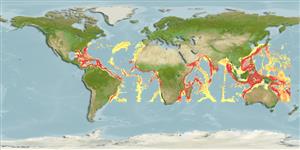Actinoptérygiens (poissons à nageoires rayonnées) >
Pleuronectiformes (Flatfishes) >
Bothidae (Lefteye flounders)
Etymology: Chascanopsetta: Greek, chaskanon, -ou = a mask used in classicla Greek theatre with the mouth opened + Greek, psetta = grouper (Ref. 45335). More on author: Alcock.
Environnement / Climat / Gamme
Écologie
; marin bathydémersal; profondeur 60 - 3210 m (Ref. 58018). Deep-water, preferred ?; 40°N - 32°S, 90°W - 168°E
Eastern Atlantic: Gulf of Guinea round the Cape to Natal, South Africa. Western Atlantic: Florida, USA and northern Gulf of Mexico to Brazil (Ref. 7251). Indo-Pacific: off the eastern coast of Africa and off India and Sri Lanka to Japan (Ref. 3322).
Taille / Poids / Âge
Maturity: Lm ? range ? - ? cm
Max length : 40.0 cm TL mâle / non sexé; (Ref. 30573); common length : 25.0 cm TL mâle / non sexé; (Ref. 30573)
Épines dorsales (Total): 0; Rayons mous dorsaux (Total): 111-127; Épines anales 0; Rayons mous anaux: 76 - 88. Body flexible. Mouth extremely large, maxillary not projecting beyond tip of snout. No canine tooth. Tip of lower jaw slightly beyond the upper; upper jaw shorter than head length.
Inhabits the deeper continental shelf to depths of almost 1,000 m (Ref. 27121). Found on sand, mud and clay bottoms (Ref. 4417). Feeds on larger benthic animals (Ref. 30573). Minimum depth reported taken from Ref. 30573.
Life cycle and mating behavior
Maturité | Reproduction | Frai | Œufs | Fécondité | Larves
Hensley, D.A., 1986. Bothidae. p. 854-863. In M.M. Smith and P.C. Heemstra (eds.) Smiths' sea fishes. Springer-Verlag, Berlin. (Ref. 4417)
Statut dans la liste rouge de l'IUCN (Ref. 115185)
CITES (Ref. 94142)
Not Evaluated
Menace pour l'homme
Harmless
Utilisations par l'homme
Pêcheries: commercial
Plus d'informations
Noms communsSynonymesMétabolismePrédateursÉcotoxicologieReproductionMaturitéFraiFéconditéŒufsDéveloppement de l'œuf
RéférencesAquacultureProfil d'aquacultureSouchesGénétiqueFréquences alléliquesHéritabilitéPathologiesTraitementMass conversion
Outils
Articles particuliers
Télécharger en XML
Sources Internet
